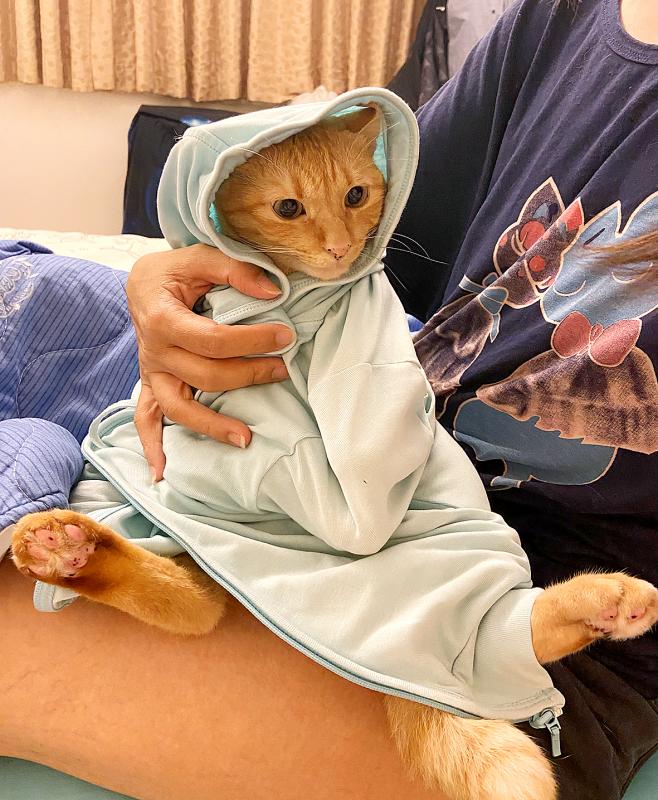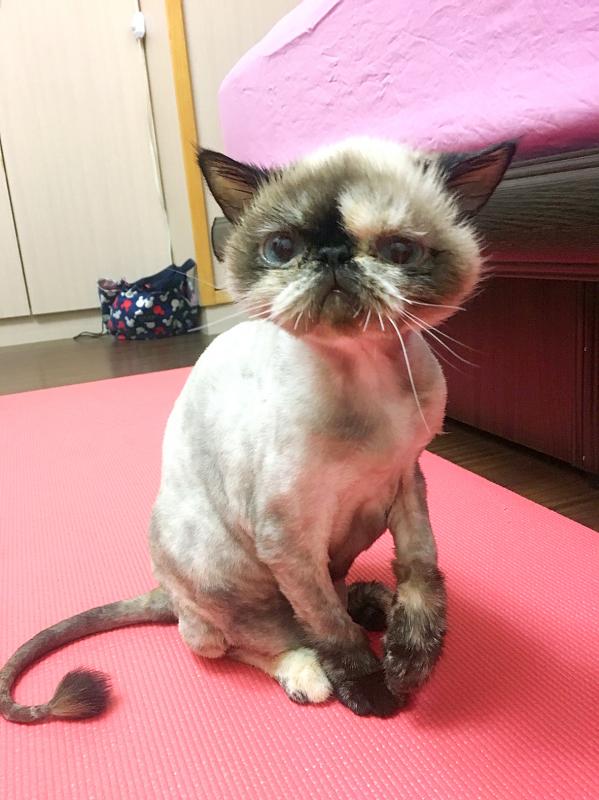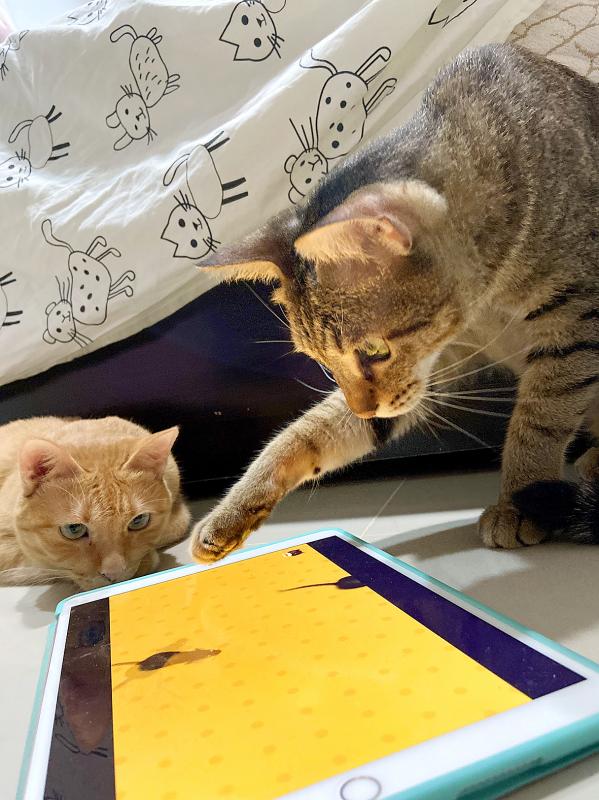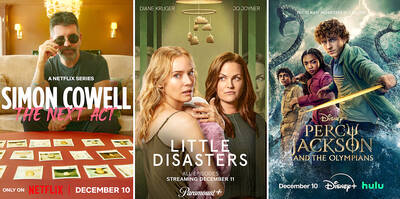In 2020, Lia Tsai (蔡利亞) decided to buy pet insurance after her Himalayan cat racked up a staggering NT$100,000 (US$3,340) in vet bills within its first year. A host of medical problems, including mold in its fluffy long fur, quickly became rows and rows of expenses tracked in her Excel spreadsheet.
After talking to an insurance agent who recommended the company’s most expensive plan, she sat down and began an intense one-night research session. Well versed in personal insurance, she read through each plan’s terms and conditions and realized that many of the advertised offerings were extraneous.
“If I don’t have a dog that roams outside or bites people, why would I need third-party liability insurance?” Tsai says.

Photo: Deanna Durben
That NT$200,000 provision made up 80 percent of the plan’s advertised maximum payout.
Pet insurance can save money and alleviate much of the financial stress around vet visits — but only if buyers are shrewd. With varying options and benefits, it’s easy to be misled by high maximums and flashy perks without considering if they actually suit your needs. Furthermore, insurance won’t cover common preventative care. Or cancer.
It raises the question of whether Taiwanese pet insurance in its current form is even worth it for the average cat or dog owner. (Iguana or clownfish owners are out of luck, as there’s no insurance for rarer pets.) Or if saving money the old-fashioned way is still better.

Photo: Deanna Durben
‘PEACE OF MIND’
Pet insurance is classified under property insurance, and mainly covers sickness or accidental damage. No preventative care is covered — vaccinations, deworming and needed nutritional supplements.
Furthermore, spaying/neutering and pregnancy-related care are considered elective. So is treatment for gum disease, which a majority of pets develop as they grow older.

Photo courtesy of Lia Tsai
Unlike human life insurance plans, yearly renewal is required. This means the companies can arbitrarily reject anyone deemed a liability, including any pet that has a chronic illness or racked up astronomical payouts the previous year.
Tsai originally settled on a cheap NT$600 plan with 50 percent coinsurance, to continue treating her cat’s myriad ongoing problems. When she applied for renewal the following year, they increased her premium to NT$900.
Seven companies offered pet insurance two years ago, when the industry was just beginning to gain traction, but the playing field has since thinned to three providers.

Photo: Deanna Durben
A typical plan costs around NT$3,000 for pets under 8. It includes up to NT$2,000 per vet visit, NT$10,000 for overnight stays and NT$50,000 for surgery. Other perks like liability, cremation fees or even locating a missing pet, vary widely between plans.
Halfway house Furiend (狗抵家) owner Hsiao Mei-fang (蕭媚方) also bought pet insurance after her dog had a series of skin problems. That year, they didn’t visit the vet once.
Nevertheless, Hsiao also insured her other two dogs the following year, after discovering a special mixed-breed policy (costing NT$$937 for their age bracket). It insures up to NT$1,100 per vet visit, but they’ve only had to go three times.
“Buying some peace of mind is definitely worth it,” Hsiao says. “Even though we didn’t use the insurance, at least we never had to worry about something happening to our pets.”
RAINY DAY FUND
However, having peace of mind means the exact opposite decision for Chiu Yan (邱雁).
Chiu, who owns four cats, says that “simply putting money aside is the most practical choice.” With varying coverage for different illnesses and treatments, it’s hard to predict what reimbursement applications will be accepted, she says, which can result in unexpected high costs.
“Your pet being sick is stressful and chaotic enough, without having to guess what procedures are covered,” Chiu says.
Furthermore, most plans stop coverage at the age of 10 or 12. Chiu couldn’t insure her oldest 14-year-old cat even if she wanted to.
Yet older pets are more likely to develop serious problems. Chiu’s cats had minimal expenses before the age of seven, then one major problem costing around NT$20,000 every two years.
Instead, Chiu has a bank account earmarked for pet care.
“Having the discipline to save regularly can be a challenge,” she says, but she believes it’s a better choice.
She saves NT$1,000 per month per cat.
“Twelve thousand per year may seem excessive in their young years, but it makes more sense than buying an insurance policy you don’t need,” she says, choosing to slowly accumulate an emergency fund.
Simple saving is an option that definitely bears consideration — and inevitably must happen as pets age out of coverage.
Insurance is a choice based on individual situations, although agents working on commission will inevitably try to convince you otherwise. In popular pet Facebook groups like Love Cat Club (愛貓聯盟), which has almost half a million members, posting anything about insurance will garner a barrage of enthusiastic comments or messages from agents.
Tsai made a popular post in 2020 detailing the restrictions and drawbacks of pet insurance — often hidden in the fine print. As thankful comments piled up, so did angry messages from insurance reps asking her to remove the post, even though she was just compiling publicly available information.
FINDING GOOD ADVICE
Good advice is hard to find. Other players in the pet care business, like pet stores and veterinary practices, don’t seem to get involved.
“It’s a purely economic decision for pet owners,” says veterinarian Yen chin-fang (顏進芳) of Tzu-en Animal Hospital (慈恩動物醫院), “so we don’t get involved.”
Clinics merely provide a receipt and diagnostic report, which can cost between NT$200 and NT$500.
When buying her current plan, Tsai asked a non-affiliated agent to present all the options, then went home to decide what policy actually fit her cat’s needs. She ended up with a NT$3,000 plan that has more than paid for itself.
Both dismissing insurance’s potential benefits and blindly buying can be foolish choices. Pet owners should analyze their own expenses and future expectations to see if any available insurance offerings match their needs.
Skipping careful consideration could leave someone missing out on major compensation or, as Tsai puts it, “subsidizing those of us who do use the insurance.”

As I finally slid into the warm embrace of the hot, clifftop pool, it was a serene moment of reflection. The sound of the river reflected off the cave walls, the white of our camping lights reflected off the dark, shimmering surface of the water, and I reflected on how fortunate I was to be here. After all, the beautiful walk through narrow canyons that had brought us here had been inaccessible for five years — and will be again soon. The day had started at the Huisun Forest Area (惠蓀林場), at the end of Nantou County Route 80, north and east

Specialty sandwiches loaded with the contents of an entire charcuterie board, overflowing with sauces, creams and all manner of creative add-ons, is perhaps one of the biggest global food trends of this year. From London to New York, lines form down the block for mortadella, burrata, pistachio and more stuffed between slices of fresh sourdough, rye or focaccia. To try the trend in Taipei, Munchies Mafia is for sure the spot — could this be the best sandwich in town? Carlos from Spain and Sergio from Mexico opened this spot just seven months ago. The two met working in the

Exceptions to the rule are sometimes revealing. For a brief few years, there was an emerging ideological split between the Democratic Progressive Party (DPP) and Chinese Nationalist Party (KMT) that appeared to be pushing the DPP in a direction that would be considered more liberal, and the KMT more conservative. In the previous column, “The KMT-DPP’s bureaucrat-led developmental state” (Dec. 11, page 12), we examined how Taiwan’s democratic system developed, and how both the two main parties largely accepted a similar consensus on how Taiwan should be run domestically and did not split along the left-right lines more familiar in

A six-episode, behind-the-scenes Disney+ docuseries about Taylor Swift’s Eras Tour and Rian Johnson’s third Knives Out movie, Wake Up Dead Man, are some of the new television, films, music and games headed to a device near you. Also among the streaming offerings worth your time this week: Chip and Joanna Gaines take on a big job revamping a small home in the mountains of Colorado, video gamers can skateboard through hell in Sam Eng’s Skate Story and Rob Reiner gets the band back together for Spinal Tap II: The End Continues. MOVIES ■ Rian Johnson’s third Knives Out movie, Wake Up Dead Man